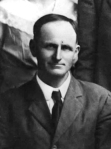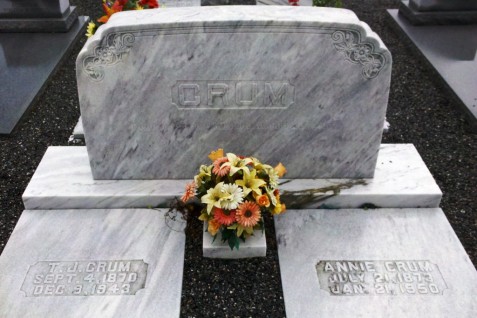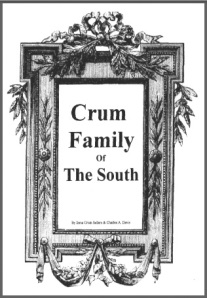The public hanging of Bob McCoy and Willie Hicks occurred on April 3, 1890 in Homerville, Clinch County, Georgia. The two men were tried and convicted of the double axe murder of William Hughes and Ellen Sellers Rice Hughes, an elderly couple of Dupont, GA. The story of the murders and the pursuit of the killers were reported in newspapers from New York to California .
As told in the previous posts the Hughes were the grandparents of Creasy Brown Woods, of Rays Mill, GA. The murders, trial, and hangings occurred when Creasy was about twelve years old.
Robert McCoy was apprehended at Live Oak, Florida by Sheriff Gottschalk “Gus” Potsdamer, who was himself an ex-convict, having been sentenced and later pardoned for the murder of another sheriff. William Hicks was arrested after a knife fight in Jasper, Florida.
The Waycross Reporter
Saturday, December 21, 1889, Pg 2The Hughes Murderers
Two of the Hughes murderers, William Hicks and Robert McCoy, are now in the Clinch County jail, and it is thought at Dupont that the other murderer, Robert Saxton, will be produced as soon as Governor Gordon offers a reward for him.
Hicks and McCoy were both captured by accident, as it were—that is to say, they were arrested for other crimes, and from a sense of guilt confessed their complicity in the Hughes murder.
Hicks was in Jasper, Florida, one night, and got into a cutting affray at a Negro candy pulling, and was arrested by Constable William Hinton, to whom he confessed.
Robert McCoy went to Live Oak after killing Hughes, and was arrested there by Sheriff Pottsdamer, for carrying concealed weapons. He said to Pottsdamer, “You have arrested me for something else than carrying a gun, and can’t fool me in this way.” “What else?” asked Pottsdamer. “For the Hughes murder,” replied McCoy. “And I was not by myself in that thing. Robert Saxton and Bill Hicks helped me.”
A curious coincidence in the matter is that Sheriff Pottsdamer, Constable Hinton, and John P. Lanier had been trying for a couple of weeks to ferret out the criminals, and by accident two of them almost fell bodily into the hands of their hunters.
Sheriff Dickerson, of Clinch County, in the mean time, had sent to Atlanta for a detective named Moyett, and he was working what he considered a good clew at Dupont, where Lanier was also working a cold trail. Moyett finally lost his trail, and tried to canter into Lanier’s. The two clashed, had hard words, and came almost to blows. Moyett then, so Lanier charges, accused Lanier and Hinton of having the murderers spotted, and conspiring with others to wait until a reward should be offered, when they would produce the murderers, and on this statement, Sheriff Dickerson telegraphed the governor not to offer a reward.
It is further alleged that when the news that Hinton had captured Hicks at Jasper reached Dupont, detective Moyett hurried on to Jasper, and offered Hinton $200.00 cash to take him into co-partnership in the capture and information gotten by Hicks’ confession, saying that he would use his influence in Atlanta to induce the governor to offer a large reward for the other two implicated by Hicks. But Hinton declined the offer with thanks. Moyett then threatened to use that same influence to prevent any reward ever being offered.
This but confirms what has often been said before—that the average professional detective is usually as unscrupulous and rascally as the criminal he seeks. Of course there are exceptions to this rule, but Moyett does not appear to be one of them.
The Waycross Reporter
Saturday, March 8, 1890, Page 2To Stretch Hemp
The two Negroes, who brutally murdered old man Hughes and his wife in Clinch County sometime ago, were tried for the murder at Homerville this week.
The courthouse was packed all day. The case of the prisoners was ably and ingeniously managed by three counsel, but the evidence offered by the state was conclusive, and left no room for doubt of guilt. The defendants themselves in making their statements, told a most blood curdling narrative of the heinous assassination; how Robert Saxton, who has since been shot and killed while resisting arrest, cam to them stating that a certain white man had agreed to pay him $35 to shoot his cousin, Orin Register, a highly respected citizen of Clinch County, and induced them to go with him to do the murder; they travelled on, and, coming to the plantation of Mr. Hughes, Saxton proposed to murder the old people and rob the house, as he knew they had some money.
All consented, and upon the pretense of desiring to buy a lunch came into the yard, and with an ax literally beat out the brains of the deceased and then plundered the house and made their escape, after dividing up the money and plunder. During the trial each was proven to have made at the time of their arrest free and voluntary confessions of their guilt. The jury after being out only a short time returned a verdict of guilty as to both defendants.
On Thursday Judge Atkinson pronounced the death sentence on the two men. They are to be hung on Friday—.”
The Macon Weekly Telegraph
March 12, 1890TO DIE ON THE GALLOWS.
Negro Murderers of Mr. and Mrs. Hughes Convicted.
McCoy and Hicks to Swing in Clinch.
April 3-They Confessed in Court
– Story of the Murderof the Hughes.
Valdosta, March 7. -Special.)- Hicks and McCoy, the negroes who murdered Mr. and Mrs. Hughes in Clinch county last fall, were found guilty in Clinch superior court yesterday and sentenced to hang on April 3.THREATS OF LYNCHING.
The case was called Wednesday. The court appointed attorneys for the defense, and all the testimony which could be obtained was examined before the court and jury, and at the conclusion when the prisoners rose to make their statement they both made a confession of the crime. Their attorneys plead for the mercy of the court. Judge Atkinson pronounced sentence upon them on Thursday morning last, and they both will hang.
There were open threats of lynching during the court and the trial of the prisoners, but the citizens of Clinch county wisely determined to let the punishment for the crime proceed in its legal and orderly way.THE MURDER OF MR. AND MRS. HUGHES
A full account of the crime for which these negroes are to hang was published in the TELEGRAPH last fall. Briefly retold it is as follows:
The murder at first was enveloped in mystery. Mr. and Mrs. Hughes, two old people living a few miles from DuPont, alone, were found one morning brutally butchered with some instrument of death, evidently an axe. Their premises had benn robbed, and the murderers and despoilers had fled, leaving no evidence of their identity. By an accident a month later two of the participants in this crime were arrested under a trivial charge at Jasper, Fla. Without inquiring into the causes of his arrest, Will Hicks said to Marshal Hinton that he knew why he had been arrested and he might as well make a clean breast of it.CONFESSED TO THE MURDER.
He proceeded then to make a confession of his part in the murder of the Hughes family and implicated Bob McCoy and Robert Saxon. McCoy, who was captured at the same time, also made a confession. When the crime was committed Saxon did not go to Florida with Hicks and McCoy, but fled to the solitude of the pine forest in Wilcox county, in this state. After remaining therer some weeks and feeling secure he wrote a letter under an assumed name to his paramour at Cat Creek, this county [Lowndes], wherein he virtually confessed his connection in the crime. The dusky female could not read the letter and called upon a male relative to read it for her.
SAXON RUN DOWN AND KILLED.
This relative had no sympathy with Saxon in his terrible crime, and reported his whereabouts to a white man neighbor. There being a reward for his capture, the two armed themselves at once and went to Wilcox county to capture him. They found him but Saxon took the chances of fight, an was fatally shot. He was brought to the Valdosta jail, confessed his crime and died.
The negroes in their confessions implicated a white man in the crime,but no evidence could be found connecting him with the crime.
The Waycross Reporter
Saturday, March 8, 1890. Page 2The Two Murderers
I have been interviewing the condemned criminals that Judge Atkinson has just passed the sentence of death upon, and are to hang April 5th next, at Homerville. I inquired into their early life and habits. In a room closely guarded near the Courthouse I found the prisoners.
The polite guards, as soon as they knew that I wanted some facts for publication, gave me permission to come in and talk with them.
Will Hicks is twenty-one years of age, was born in Perry, Georgia, where his father now lives. He has been in this section of the state about four years, and was mainly engaged in turpentine work. He cannot read.
Robert McCoy, was born in Sumter County, South Carolina. He is 19 years old, can read a little, and once belonged to the church, but when he came out to this state, he soon drifted with the tide of evil so prevalent on these turpentine farms.
Both of these Negroes are of the deepest African type, the animal showing in their faces and heads as predominating over the intellectual. Indeed, so deep is their depravity that they seem to be under a stupefying influence that is altogether satanic. They do not realize their danger, being ignorant of the law. They were the willing dupes of Saxton, a mulatto of some shrewdness, and much of the demoniac in his mental make up. In my interview with these doomed men I elicited as the prime cause of their terrible crime these three things: whiskey, cards, and bad company. Let it be emphasized, and let all men, black and white, know that these are three of the most prominent steps to the gallows. Let the young men, especially, take warning. Because everyman that drinks, plays cards, and keeps bad company is on the road to the gallows, and will get there sooner or later, unless he stops or takes another road.
The sentence, as passed by Judge Atkinson, was so impressive, that in breathless awe the full house of hearers stood as if transfixed for the time being.
Atlanta Constitution
April 4, 1890TWO MEN HANGED.
The Murderer of Old Man Hughes Pays the Penalty.
The Assassins Meet Their Fate With Dogged Indifference – The Story of Their Crime and Subsequent Capture.
Waycross, Ga., April 3. -[Special.]- Robert McCoy and Will Hicks, colored, were hanged publicly at Homerville today, for the murder of William Hughes and wis wife. The drop fell at 1:03. They died in fourteen minutes from strangulation.
THEY DIED GAME.
Both men confessed the brutal crime which they had committed, and died game. They both passed their last night on earth as though nothing was to transpire on the morrow. After a meagre breakfast they chatted cheerfully and passed the forenoon in singing and praying. At dinner their menu consisted of a cup of coffee and biscuit. About 4,000 followed the procession to the gallows.
THE MURDER OF THE MILLERS.
The murder which they expiated today was one of the most cold-blooded in the catalogue of crime. They were hired to kill other parties, and while en route to do their dastardly work, ascertained that Mr. Hughes was known to keep considerable money in the house, and they decided that it would be more lucrative to murder the Hughes family instead.
They lingered around the premises until evening, and quietly approached the house, found the old lady in the kitchen when she was most cruelly murdered with an ax, and then leaving the kitchen, they met the husband at the gate, and served him similarly. The ax with which this atrocious crime was committed is still on exhibition. It was not until the following morning that the murdered bodies were discovered.ONE OF THE ASSASSINS KILLED.
Robert Saxton, a third party who aided in this inhuman act, was killed while resisting arrest, thus cheating the gallows of what he deserved.
Related articles
- The Bloody Story: 1889 Murder of the Hughes Family in Clinch County (raycityhistory.wordpress.com)
- Creasy Brown Woods buried at Dupont, GA (raycityhistory.wordpress.com)


























